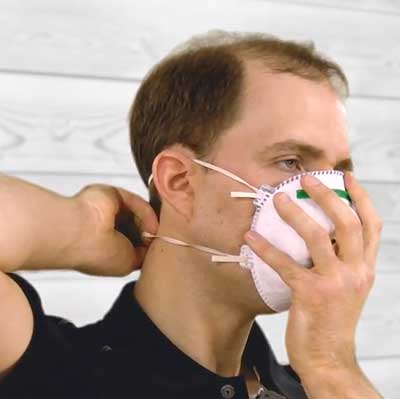What is a particulate respirator?

Particulate respirators are aptly named for the small, airborne particles they protect you against. Most commonly, a particulate respirator looks like it’s made out of paper and is a half-mask style respirator that’s disposable. It may have one or two straps. Some particulate respirator styles also have an exhale valve. Particulate respirators also come in the form of disposable filters that are added to a single-cartridge or dual-cartridge half-mask or full-mask reusable respirator. Regardless of its form, particulate respirator refers to its function, which is to protect the wearer from small particles in the air, such as dust, mists, pollen and certain low-toxicity pesticides (see product label to be sure) that can interfere with safe breathing.
Proper use of a particulate respirator provides a protective barrier between these particles and the air you breathe into your lungs. Particulate respirators help protect your lungs by preventing these small, hazardous particles from being inhaled into your lungs.
When is a particulate respirator the right choice for protection?
Choose the proper respirator for the hazards you are working around. When you are working in conditions where there are small particles in the air, such as dust, mists, pollen and certain low-toxicity pesticides (see pesticide product label to be sure), proper use of a particulate respirator provides a protective barrier between these particles and the air you breathe into your lungs.
A particulate respirator is not sufficient protection against gaseous fumes or vapors, like anhydrous ammonia, paint fumes, pesticide vapors and other vaporized contaminants. In that case, you should use a dual-cartridge respirator with the proper gas/vapor cartridge, with or without a particulate pre-filter, for adequate protection.
Who should NOT use a particulate respirator
- You shouldn’t wear a particulate respirator if you have
- a beard, mustache, long sideburns, a deep facial scar or deformity that would make it difficult to achieve a safe, tight seal between the facepiece and your face.
- Lung disease, heart trouble or breathing problems. In this case, talk to your employer or a physician before using a respirator. He or she may recommend alternatives.
- Information that the hazards you want to protect yourself against require another type of respirator
- In the case of pesticides, always check the pesticide label to ensure you choose the right form of respirator protection based on the pesticide contents.
- Some styles of particulate respirator accommodate glasses or goggles better than others.
How to put on a particulate respirator
- Hold the respirator in your hands with the nose piece toward your fingertips. Position the mask over your mouth and nose.
- Secure the respirator strap(s) in place.
- With two-strap respirators, pull one strap over the top of your head and place above your ears, and place the bottom strap below your ears.
- If there is only one strap, follow the product directions.
- Adjust the nose piece. Some respirators have form-fitting tabs on the nose piece.Using both hands at once, use your index fingers to mold the nose piece to the shape of your nose.
- Adjust the facepiece and straps for a comfortable fit. Be sure there’s a tight seal between your face and the facepiece.
- Check the written material that comes with your respirator for additional fitting instructions.




How to perform a fit check for your particulate respirator
Check your particulate respirator for the proper fit each time you put it on. Here’s how:
- Cup both hands in front of the mask. But be careful not to push on the mask or move it.
- Inhale deeply. Check to see if the facepiece collapses toward your face.
- Smile, then frown. If the mask is drawn in and no air is leaking in around the edges, you have a proper fit.
- If you don’t have a proper fit, try readjusting the straps or repositioning the respirator on your face.
- Repeat the test until you have a proper fit.
- Check the written material that comes with the respirator for other specific fitting instructions.

Particulate respirator do’s and don’ts
Do
- Check with your employer and/or the product label for the hazard you’re working with for which type of respirator you should use.
- Fit check the respirator each time you put it on
- Throw away the respirator if it is dirty, damaged, or difficult to breathe through.
Don't
- Use a particular respirator for protection against pesticide vapors or gaseous contaminants.
- Wear the mask if breathing becomes difficult.
- Go into a potentially hazardous area without first checking the respirator for the proper fit.
Make sure you choose the proper protection for you and your crew. Some contaminants require the use of a reusable, dual-cartridge respirator. For information on dual-cartridge respirators, click here.
When you’re ready to work safely, you’re ready to work. See our full line of safety supplies, including respirators, eye and ear protection, coveralls, first aid and more.







